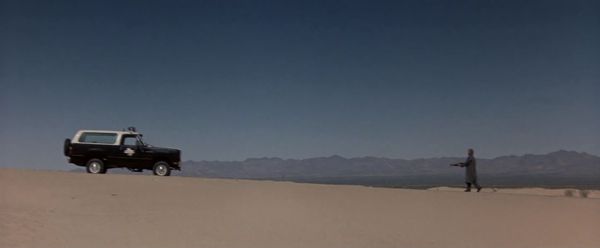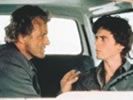Eye For Film >> Movies >> The Hitcher (1986) Film Review
The Hitcher
Reviewed by: Donald Munro

The night is dark. In the distance a small speck of light speeds through jagged hills. The shadows in a car's cramped interior frame the driver as he strikes a match, smokes a cigarette. A storm is coming. He falls asleep. A flash of light, the headlights of an oncoming truck, wake him from the dreamworld. That's how The Hitcher starts. Before even one word of dialogue is spoken, it has packed in the much of the imagery that will permeate the rest of the film.
In a small and naïve act of rebellion, Jim Halsey (C Thomas Howell), the driver, picks up a hitcher, John Ryder (Rutger Hauer). Ryder acts in a physically and psychologically intimidating way towards Howell. After Howell eventually expels Ryder from the car, a game of cat and mouse begins. Ryder murders a nuclear family almost in its entirety (later the little girl is briefly seen riding in the passenger seat of his big black pickup truck) and frames Halsey for the crime. Ryder violently interferes with the police, making Halsey's position progressively worse. The only person to offer Halsey succour is Nash (Jennifer Jason Leigh), a waitress at a diner.

Hauer's Ryder isn't a typical Hollywood villain. There is something eldritch about him; he's like a malevolent desert spirit. The way he interacts with Halsey is creepily affectionate. Even when he is at the centre of carnage he seems less culpable, like it's all part of a preset game or ritual.
Between the anamorphic desert landscapes and Mark Isham's electronic score with its lingering notes, The Hitcher has an otherworldly quality. Sleep, a mirror, coins on eyes, a dog all hint at something beyond. Whenever Halsey wakes from the dreamworld his waking nightmare worsens.
Although The Hitcher is full of supernatural imagery it is defiantly not supernatural horror. The events in the film, even when they seem improbable, have an internally consistent, real world logic about them. There is a plausible explanation for everything, if you've been watching carefully. Instead the imagery lends itself to mutable and coexistent subtexts. The Hitcher is unconventional for a Hollywood film; the events in it are self contained, placeless, timeless. There is no backstory, no subplot, and no explanation for what is going on. There is just the desert and the distant mountains looking down, like old gods that just don't care. It is a mirror to the viewer's own concerns and experiences. As such almost any reasonable meaning can be read into it. There is the homoerotic subtext: Ryder uses sexual intimidation to control Halsey. Cars and guns, phallic symbols galore. It's about toxic masculinity. The parental aspect, Nash and Tom Spratley's character stand in as loving parent, Hauer as a coercive, controlling father. The anti-authoritarian: throughout the film Ryder mostly kills cops while at the same time he makes Halsey more and more like himself. The Hitcher also easily fits a coming of age interpretation.
For all that the Hitcher is an ambiguous horror film it is also a spectacular piece of Eighties action cinema. Some of the practical stunts are spectacular. Double barrel rolling cars into the camera is simply more visceral than anything Fast And Furious. The DOP John Seale (Mad Max: Fury Road) brings an Australian cinematic sensibility to the copious action.
Straddling two genres, ambiguous, and with sparse dialogue, The Hitcher didn't go down well when it was released. The brilliant performances by C Thomas Howell, Rutger Hauer and Jennifer Jason Leigh were ignored. Beautiful cinematography, the score and stunt work all ignored. Art ignored. Just as Jim Halsey transforms from an incongruous youth in a red checked shirt to a drab desert creature, The Hitcher has transformed into a classic.
Reviewed on: 29 Sep 2024




















